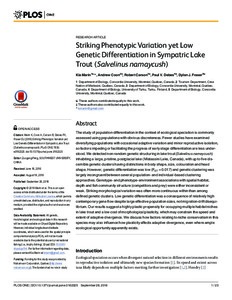Striking Phenotypic Variation yet Low Genetic Differentiation in Sympatric Lake Trout (Salvelinus namaycush)
Kia Marin; Andrew Coon; Robert Carson; Paul V. Debes; Dylan J. Fraser
Striking Phenotypic Variation yet Low Genetic Differentiation in Sympatric Lake Trout (Salvelinus namaycush)
Kia Marin
Andrew Coon
Robert Carson
Paul V. Debes
Dylan J. Fraser
Public Library of Science
Julkaisun pysyvä osoite on:
https://urn.fi/URN:NBN:fi-fe2021042718785
https://urn.fi/URN:NBN:fi-fe2021042718785
Tiivistelmä
The study of population differentiation in the context of ecological speciation is commonly assessed using populations with obvious discreteness. Fewer studies have examined diversifying populations with occasional adaptive variation and minor reproductive isolation, so factors impeding or facilitating the progress of early stage differentiation are less understood. We detected non-random genetic structuring in lake trout (Salvelinus namaycush) inhabiting a large, pristine, postglacial lake (Mistassini Lake, Canada), with up to five discernible genetic clusters having distinctions in body shape, size, colouration and head shape. However, genetic differentiation was low (FST = 0.017) and genetic clustering was largely incongruent between several population- and individual-based clustering approaches. Genotype- and phenotype-environment associations with spatial habitat, depth and fish community structure (competitors and prey) were either inconsistent or weak. Striking morphological variation was often more continuous within than among defined genetic clusters. Low genetic differentiation was a consequence of relatively high contemporary gene flow despite large effective population sizes, not migration-drift disequilibrium. Our results suggest a highly plastic propensity for occupying multiple habitat niches in lake trout and a low cost of morphological plasticity, which may constrain the speed and extent of adaptive divergence. We discuss how factors relating to niche conservatism in this species may also influence how plasticity affects adaptive divergence, even where ample ecological opportunity apparently exists.
Kokoelmat
- Rinnakkaistallenteet [27094]
